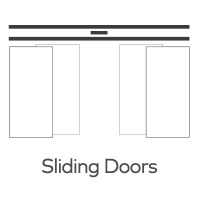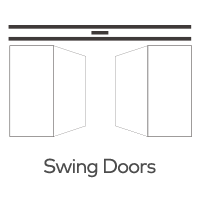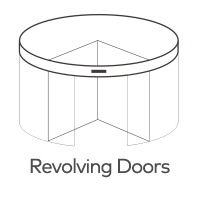What types of safety sensors are available for automatic doors?
Automatic doors have become an essential feature in various settings, including commercial buildings, hospitals, and airports, offering convenience and improved accessibility. To ensure these doors operate safely and efficiently, a range of safety sensors are utilized. These sensors detect obstacles, prevent accidents, and enhance security. Here are the primary types of safety sensors available for automatic doors:

1. Infrared Sensors
Active Infrared Sensors: These sensors emit infrared light beams across the doorway. When an object or person interrupts the beam, the sensor triggers the door to stop or reverse its motion. Active infrared sensors are highly effective in detecting movement and presence, ensuring that the door does not close on any obstruction.
Passive Infrared Sensors: These sensors detect changes in the infrared energy within their field of view. When a person or object enters this field, the sensor detects the change in energy and activates the door. Passive infrared sensors are commonly used in applications where detecting the presence of heat-emitting objects is crucial.
2. Ultrasonic Sensors
Ultrasonic sensors emit high-frequency sound waves that bounce off objects and return to the sensor. By measuring the time it takes for the sound waves to return, these sensors can determine the presence and distance of an object. Ultrasonic sensors are particularly effective in environments where precise detection of movement and presence is required, such as in hospitals or busy commercial buildings.
3. Microwave Sensors
Microwave sensors use microwave radar technology to detect motion. When an object moves within the sensor's range, the reflected microwaves change, triggering the door to open or stay open. These sensors are known for their high sensitivity and reliability, making them suitable for high-traffic areas where quick response times are essential.
4. Pressure Sensors
Pressure sensors are typically installed on the floor near the doorway. They detect changes in weight or pressure when someone steps on the sensor mat, triggering the door to open. Pressure sensors are ideal for ensuring the door remains open as long as someone is standing on the mat, providing an added layer of safety and preventing the door from closing prematurely.
5. Contact Sensors
Contact sensors, also known as touch sensors, require physical contact to activate the door. These sensors are often used as a secondary safety measure, ensuring that the door only operates when deliberately touched or pressed. This type of sensor is less common in high-traffic areas but can be useful in controlled environments where accidental activation needs to be minimized.
6. Safety Edges
Safety edges are pressure-sensitive strips installed along the edges of automatic doors. When an obstruction is detected by the pressure on the safety edge, the door stops or reverses its motion. These sensors are particularly useful for preventing accidents involving the door's edges and ensuring that the door operates safely even if the primary sensors fail.
7. Light Curtains
Light curtains consist of multiple infrared beams arranged in a grid pattern across the doorway. If any of the beams are interrupted, the door will stop or reverse its motion. Light curtains provide a comprehensive detection field and are highly effective in ensuring the safety of users, particularly in environments with high pedestrian traffic.
8. Magnetic Sensors
Magnetic sensors use magnetic fields to detect the presence of objects or people. These sensors are often used in combination with other types of sensors to enhance safety and reliability. Magnetic sensors are known for their durability and are particularly useful in harsh environments where other sensors might fail.
Conclusion
The variety of safety sensors available for automatic doors ensures that these systems can be tailored to meet the specific needs of different environments. Infrared, ultrasonic, microwave, pressure, contact sensors, safety edges, light curtains, and magnetic sensors each offer unique advantages in detecting obstacles, preventing accidents, and enhancing the overall safety and efficiency of automatic doors. By selecting the appropriate combination of sensors, building managers and owners can ensure that their automatic doors provide a safe, reliable, and user-friendly experience for all users.







